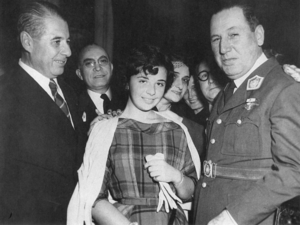Nélida Rivas
Nelida Haydee Rivas (known as Nelly) was born on April 21, 1939 in Buenos Aires, Argentina and died on the August 28, 2012. She was the mistress of Juan Domingo Peron, President of Argentina, during the early 1950s.

Early Life
Nelida Haydee Rivas was born on April 21, 1939, at the Rawson hospital in Buenos Aires, the only daughter of José María Rivas and María Sebastiana Viva. Rivas was a worker at the Noel confectionery factory and his wife worked as a caretaker in an apartment building.
Encounter with Peron
As a teenager, she participated in the activities organized in the UES or Union of Secondary Students (female branch), a Peronist organization in which high school students met in the Presidential Residence at Olivos. At this time she met President Peron and became linked sentimentally, and sexually, with the Argentine president between the years 1953-1955, after the death of Evita Perón At the time they first met she was either 13 or 14 years of age.[1][2]
"I was speechless. I felt a chill run through my body. I began to tremble like a leaf (...) I had been stunned by his simplicity and cordiality. I hadn't expected him to be so handsome either." This is how Nelly described her first face to face with Juan Domingo Perón.
"Perón, in our workers' house, was a god (...) It would be a great falsehood not to recognize that each one of us wanted to be a second Evita," Nelly told Zavala, according to what he says in his book.
Though much of Argentina's media had, since 1950, been either controlled or monitored by the administration, lurid pieces on his ongoing relationship with an underage girl, something Perón never denied, filled the gossip pages.[3] Pressed by reporters on whether his supposed new paramour was, as the magazines claimed, thirteen years of age, the fifty-nine-year-old Perón responded that he was "not superstitious."[4]
Life after Peron
When Perón was overthrown in September 1955, she was arrested with her family in the province of Chaco. During the military government calling itself the "Revolución Libertadora" (Liberating Revolution), her parents were convicted and confined in the Villa Devoto Prison, while Nelly was transferred to a Correctional Asylum for Minors.
The letters she exchanged with Perón were officially published in 1957 by a newspaper in the United States, while Perón was prosecuted for rape, a crime that occurs when an adult maintains a consensual relationship with a minor under 15 years of age (she was 14 when he started the relationship).[5] This prosecution was prescribed in 1971 whilst Perón was negotiating with the de facto president Alejandro Agustín Lanusse the legalization of the Partido Justicialista.[6][7]
Nelly married in 1958 and, in 1973, she reunited with Perón when he returned for his third presidency. Nelly at that time had two children.
She died on the 28th of August 2012 at the age of 73.
References
- Ella tenía 14, él 60: el testimonio de la joven que fue amante de Perón
- El relato de la "amante" de 14 años de Juan Domingo Perón, Nelly Rivas
- "The Hemisphere: Daddykins & Nelly". Time. 10 October 1955. Retrieved 27 January 2011.
- Martínez, Tomás Eloy (1997). La Novela de Perón. Vintage Books.
- Alaniz, Rogelio (18 April 2013). "Perón, Nelly Rivas y "la fiesta del chivo"". El Litoral. Santa Fe. Retrieved 25 May 2019.
- Rodríguez, Daniel (22 April 2018). "Ella 14, él 60: La historia de la joven amante de Perón". Retrieved 25 May 2019.
- Gambini, Hugo (2008). Historia del peronismo. La violencia (1956-1983). Buenos Aires: Javier Vergara Editor. p. 242. ISBN 978-950-15-2433-8.
Bibliography
- Nuestro Siglo: Historia de la Argentina, Tomo 1949-1955 "Escándalos y Frivolidades". Director y autor de la obra: Félix Luna. Hyspamérica y Editorial Sarmiento S.A. (1992).
- Amor y Violencia: La verdadera historia entre Perón y Nelly Rivas. Del autor Juan Ovidio Zavala. Editorial Planeta (1987).
- Nelly R., la niña amante de Perón: Novela (anti)histórica. Del autor Santiago Giralt (1994).
- Las vírgenes de Perón. Del autor Ignacio Yrigoyen. Ediciones B (1990).